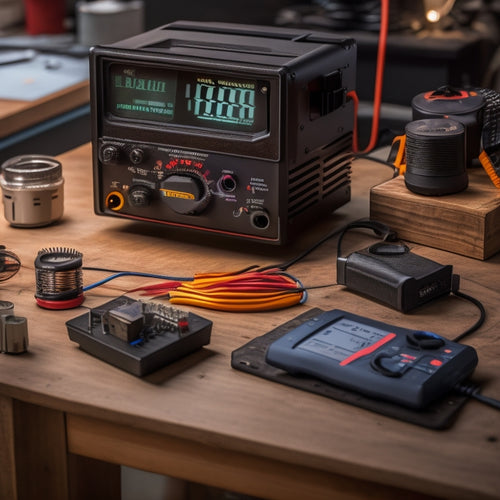
What Makes a Perfect Energy System Design
Share
You design a perfect energy system by combining accurate load evaluations, optimized component selection, and efficient system configuration to guarantee a seamless integration of sustainable energy sources, efficient energy storage, and reliable grid operation. This involves evaluating your energy needs, choosing the right components, and optimizing system configuration to prioritize energy efficiency and renewable energy integration. By integrating smart grid technologies, renewable energy sources, and demand response strategies, you can create a resilient and efficient energy system that meets your needs while minimizing environmental impact. As you consider these factors, you'll be well on your way to creating an energy system that's optimized for performance and sustainability.
Overview
- A perfect energy system design starts with an accurate assessment of energy needs, considering factors like consumption patterns and demand forecasting.
- Choosing the right components, such as energy storage options and power conversion components, is crucial for reliability and efficiency.
- Optimizing system configuration involves load balancing, prioritizing energy efficiency, and ensuring scalability for future needs.
- Effective system maintenance and monitoring are essential for identifying issues early, reducing downtime, and extending equipment longevity.
- Integrating with existing infrastructure and incorporating smart grid technologies, renewable energy sources, and demand response strategies is vital for a perfect energy system design.
Assessing Your Energy Needs
Your energy system's performance relies heavily on accurately evaluating your energy needs. To do this, you'll need to conduct a thorough load assessment, examining your energy consumption patterns and peak demand periods. This will enable you to create an effective demand forecasting strategy, ensuring your system can meet your needs efficiently.
Efficiency metrics, such as energy audits, will help you identify areas for improvement, while cost analysis will guide your decisions on renewable integration. By aligning your energy system with your sustainability goals, you'll be able to optimize performance, reduce costs, and minimize environmental impact.
To accurately size your solar battery backup system, you should calculate total wattage and daily energy usage of all connected appliances and devices, and consider tools like watt meters and energy monitoring software for data collection.
An extensive understanding of your energy needs is the foundation of a well-designed energy system, giving you the freedom to make informed decisions about your energy future.
Choosing the Right Components
When designing your energy system, you'll need to select components that meet your specific energy needs.
You'll choose from various energy storage options, such as batteries or supercapacitors, to guarantee a reliable power supply.
It's essential to verify system compatibility and integration among components, including grid ties, solar panels, and inverters, to prevent downtime and guarantee reliable performance.
You'll also need to select efficient power conversion components, like inverters or converters, to minimize energy losses and optimize system performance.
Energy Storage Options
As designers of energy systems, we need to carefully consider the energy storage options to guarantee a reliable and efficient system. When selecting energy storage solutions, you'll want to evaluate various battery technologies, such as lithium-ion, lead-acid, and flow batteries, based on their performance metrics, cost, and environmental impact. You must also consider renewable integration, grid interaction, and scalability options to ascertain a seamless and sustainable energy supply.
| Energy Storage Option | Key Characteristics |
|---|---|
| Lithium-Ion Batteries | High energy density, long lifespan, and low self-discharge rate |
| Lead-Acid Batteries | Low upfront cost, well-established manufacturing infrastructure, and simple maintenance |
| Flow Batteries | Scalable design, flexible operation, and long-duration energy storage |
Efficient Power Conversion
You're tasked with designing an energy system that efficiently converts power to meet the demands of your application. To achieve this, you'll need to select the right power electronics components.
Inverter selection is essential, as it directly impacts conversion efficiency. Confirm load matching to optimize performance and minimize energy losses. Thermal management is also critical, as it affects component lifespan and overall system reliability.
When designing your system, consider high-efficiency inverter options with high conversion efficiency ratings, typically above 95%, to maximize energy harvesting during peak sunlight hours. Additionally, advanced features like monitoring and control systems for real-time tracking can provide beneficial observations into energy usage and production.
When designing your system, consider grid interaction and scalability to guarantee seamless integration and future upgrades. Establish clear efficiency metrics and implement performance monitoring to track your system's effectiveness.
Optimizing System Configuration
How can you guarantee that your energy system configuration meets the required performance, reliability, and cost targets? By optimizing your system configuration, you can ascertain that your energy system operates at peak efficiency.
This involves implementing load balancing and demand forecasting to match energy supply with demand. You must also prioritize energy efficiency, integrate renewable energy sources, and design a system that's scalable to meet future needs.
Regulatory compliance and grid interconnection requirements must also be considered. To engage users, provide real-time performance monitoring and cost analysis.
Ensuring Efficient Energy Storage
Three key components of an efficient energy system are generation, transmission, and storage.
When designing an energy system, you'll want to guarantee that your storage component is efficient. This means selecting battery technologies that offer high energy density, long storage longevity, and effective thermal management.
You'll also need to take into account the number of charging cycles, discharge rates, and system scalability to ascertain that your energy storage system can meet your needs.
Additionally, cost efficiency, environmental impact, and adherence to safety standards are vital factors to evaluate.
Considering System Maintenance
Designing an efficient energy system requires careful consideration of maintenance needs to guarantee continuous operation and minimize downtime. You must prioritize preventive maintenance to identify potential issues before they escalate.
Establishing maintenance schedules helps assure that routine checks are performed regularly. Troubleshooting techniques and maintenance training for operators are also essential to quickly resolve issues.
Proper maintenance extends equipment longevity, reducing the need for costly repairs and minimizing maintenance costs. Implementing system monitoring allows you to detect potential problems early, enabling proactive repair strategies.
Integrating With Existing Infrastructure
When integrating your new energy system with existing infrastructure, you'll need to perform a system compatibility check to guarantee seamless interaction between old and new components.
This involves identifying potential points of conflict and evaluating the feasibility of integration.
You'll also need to investigate infrastructure upgrade paths to determine the most cost-effective and efficient ways to bring your existing infrastructure up to speed.
System Compatibility Check
During the system design process, your attention turns to guaranteeing the new energy system integrates seamlessly with the existing infrastructure. You must consider various system types, such as renewable energy systems, energy storage systems, and grid management systems. Compatibility factors like performance benchmarks, scalability options, and regulatory compliance are essential to guarantee a smooth integration.
| System Type | Compatibility Factors | Challenges |
|---|---|---|
| Renewable Energy Systems | Performance benchmarks, technology advancements | Integration challenges, cost implications |
| Energy Storage Systems | Scalability options, regulatory compliance | Testing protocols, future proofing strategies |
| Grid Management Systems | System compatibility, data exchange standards | Integration with existing infrastructure, cost implications |
Infrastructure Upgrade Paths
Upgrading existing infrastructure to accommodate the new energy system is an essential step, requiring careful planning to guarantee a seamless integration.
You'll need to assess your current infrastructure's limitations and identify areas that require upgrades to support the new system. This might involve integrating with smart grid technologies, enabling renewable integration, and implementing demand response strategies.
Load forecasting will help you anticipate energy demands and assure a stable supply. Microgrid solutions can provide energy resilience and grid interoperability, assuring that your system can operate independently or in conjunction with the main grid.
Frequently Asked Questions
How Do I Ensure System Reliability in Extreme Weather Conditions?
You guarantee system reliability in extreme weather conditions by implementing resilience strategies, such as redundant components and backup power sources, and leveraging advanced weather forecasting to predict and prepare for severe weather events.
Can I Use My Energy System for Backup Power During Outages?
You can confidently use your energy system for backup power during outages by incorporating battery storage and advanced power management, ensuring seamless changes between grid and off-grid modes, and keeping your essential loads running smoothly.
Are Energy Systems Compatible With All Types of Buildings?
You'd think energy systems are as finicky as a celebrity's entourage, but surprisingly, they're compatible with most building types, from sleek skyscrapers to rustic cabins, as long as you choose a system that's adaptable and scalable to your structure's unique needs.
Do Energy Systems Require Special Permits or Licenses?
You'll need to maneuver permit requirements and licensing regulations to guarantee your energy system meets system safety and compliance standards, which vary by region, so it's crucial to research and comply with local authorities to avoid costly delays.
Can I Expand My Energy System in the Future if Needed?
You'll want to future-proof your energy system, and guess what? You can! With a design that's ridiculously scalable and flexible, you'll be able to expand or modify it as needed, giving you the freedom to adapt to changing energy demands.
Ready to Buy
As you finalize your perfect energy system design, finesse fusion of form and function unfolds. Flawless fusion of components, optimized configuration, and efficient energy storage converge to create a harmonious whole. With careful maintenance and seamless integration into existing infrastructure, your system synchronizes smoothly, supplying sustainable power with precision and reliability.
Related Posts
-

Top Camping Water Bottles for Adventure
When you're out adventuring, picking the right camping water bottle is essential for staying hydrated. Look for durab...
-

Designing a Green Roof for Maximum Energy Efficiency
Designing a green roof for maximum energy efficiency involves several key strategies. Start by selecting native, drou...
-

Key Features of a DC to AC Converter
A DC to AC converter features high efficiency and conversion rates, which reduce energy costs and improve performance...


